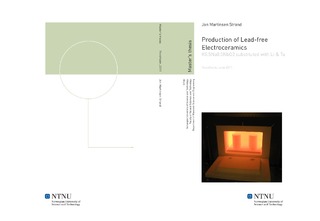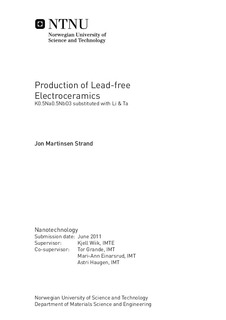| dc.contributor.advisor | Wiik, Kjell | nb_NO |
| dc.contributor.advisor | Grande, Tor | nb_NO |
| dc.contributor.advisor | Einarsrud, Mari-Ann | nb_NO |
| dc.contributor.advisor | Haugen, Astri | nb_NO |
| dc.contributor.author | Strand, Jon Martinsen | nb_NO |
| dc.date.accessioned | 2014-12-19T13:25:44Z | |
| dc.date.available | 2014-12-19T13:25:44Z | |
| dc.date.created | 2012-04-20 | nb_NO |
| dc.date.issued | 2011 | nb_NO |
| dc.identifier | 517067 | nb_NO |
| dc.identifier | ntnudaim:6449 | nb_NO |
| dc.identifier.uri | http://hdl.handle.net/11250/248902 | |
| dc.description.abstract | K0:485Na0:485Li0:03Nb0:8Ta0:2O3 powder has been prepared by spray pyrolysis ofaqueous solutions of K/Na/Li nitrates mixed with water soluble Nb and Ta precursors.The as-prepared ceramic powder was calcined at 600 °C to remove any organic residuesafter the spray pyrolysis process. Different milling methods for the calcined powderswere attempted, revealing dry planetary milling to be the most suitable milling method.The powders were characterised using scanning electron microscopy. A complete millingprocess was developed based on sufficient destruction of the egg-shell like agglomerates from the spray pyrolysis process, avoidance of flake formation and reproducibility.Sintering was attempted using three different sintering methods, all using the reverse crucible method to limit the amount of alkali evaporation. An optimal temperature range was found for each of the three, achieving densities in the range of 94-97%. The microstructure of the different samples was explored by polishing the samples and investigating the surfaces by scanning electron microscopy. It was found that the average grain sizes were in the range of a few microns, with large variations in the broadness of the grain size distribution when comparing different sintering methods. For two of the three sintering methods a standard deviation of less than 0.3 micron is reported. An EDS analysis was performed, and it was found that all the samples demonstratecompositional homogenity.Dielectric testing was performed on the samples sintered using the three differentsintering methods. Polishing of the sample surfaces and storage in dessicators had tobe performed in order to avoid moisture influence and achieve reproducibility. Thepiezo- and ferroelectric effect was observed for all the different sintering methods, along with coercive fields in the range of 669 - 889 Vmm and remnant polarizations in the range of 16 - 29 C/cm2 , depending on the sintering method used. A strictly monotonic relationship between average grain size and the coercive field was identified. The normalized strain d*33 was found to be in the range of 230 - 330 pm/V , after poling using an electric field of 4 kVmm at 100 °C. It is argued that on the basis of the present results,K0:485Na0:485Li0:03Nb0:8Ta0:2O3 has potential as a leading candidate for environmentally friendly ferroelectric materials, and spray pyrolysis seems an excellent choice of synthesis method. | nb_NO |
| dc.language | eng | nb_NO |
| dc.publisher | Institutt for materialteknologi | nb_NO |
| dc.subject | ntnudaim:6449 | no_NO |
| dc.subject | MTNANO Nanoteknologi | no_NO |
| dc.subject | Nanoteknologi for materialer, energi og miljø | no_NO |
| dc.title | Production of Lead-free Electroceramics: K0.5Na0.5NbO3 substituted with Li & Ta | nb_NO |
| dc.type | Master thesis | nb_NO |
| dc.source.pagenumber | 99 | nb_NO |
| dc.contributor.department | Norges teknisk-naturvitenskapelige universitet, Fakultet for naturvitenskap og teknologi, Institutt for materialteknologi | nb_NO |

